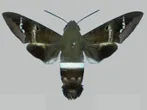Harmful Effects of Sequoia sphinx moth
A species of Sphinx
Sequoia sphinx moth larvae can cause defoliation in host plants, potentially resulting in slowed growth and reduced vigor. The severity of the impact varies with infestation levels.
What Type of Pest Is Sequoia sphinx moth?









AI entomologist in your pocket
Scan QR code to download

